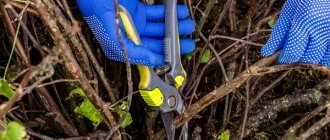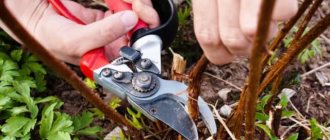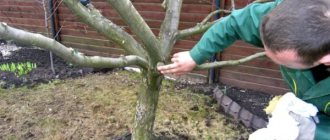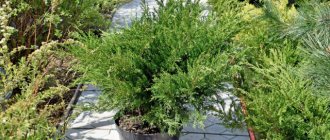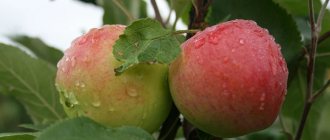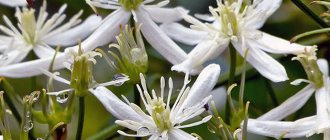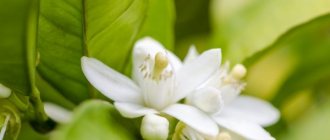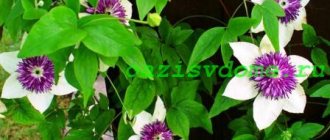Conditions for growing thuja
Thuja should grow in well-drained, fertile and moderately moist soil. In dry soil it may die. You can take ready-made soil for coniferous trees, available in stores, or peat substrate mixed with rotted compost or pine bark. Around trees, gardeners recommend covering the soil with forest soil or soil with a mulch of needles and pine cones. In what soil should thuja be planted, given the type of plant? It should be remembered that the western thuja (Arborvitae) grows best in calcareous soil, while the oriental thuja, or eastern cedar, loves acidic soil.
There should be no weeds or earthen clods in the place chosen for planting. If thujas are planted as a hedge, you need to prepare a plot of land at least 80 cm wide. The entire area is covered with black film until planting to prevent weeds from appearing.
When planting, thujas take a lot of fertile soil. Its quantity should exceed three times the size of the hole. You need to pour thirty centimeters of soil at the bottom and immediately spill it with water. Place a seedling on it, cover it with soil, press the soil down and water it again.
After planting the seedling, you need to apply mycorrhizal grafting material. To slow down the development of weeds and reduce water evaporation, pine bark is laid out in a thick layer around the thuja.
Description and features of thuja Danika
Thuja "Danika" is an evergreen shrub of the cypress family, a dwarf form of the western thuja. It has a spherical shape. Thuja "Danika" grows up to 60-75 cm in height. The crown reaches a diameter of up to 1 m.
The culture is characterized by slow growth, since in one year it grows only up to 5 cm in height and 4 cm in width. The crown of the tree is dense. The needles are green, soft to the touch, and scaly. All branches are directed upwards, which gives the plant an attractive appearance.
The plant does not bloom profusely. It is extremely rare to see small (up to 60 mm in length) rounded brown cones. Seedlings of thuja "Danika" are small (up to 10 mm in length) needles. They are called juveniles. Then they turn into flat scales that fit tightly to each other.
Did you know? With proper care, the plant can live up to 100 years.
Retains its decorative appearance throughout the year. Tolerates winter cold well.
Why do you need fertilizing?
For normal growth and development, any plant needs a balanced diet. But the soil cannot remain fertile forever; every year the nutrients in it become less and less. Half of them are washed out with groundwater, half are absorbed by plant roots. Without receiving enough nutrients, the plant begins to get sick and then may die. How to recognize what elements a thuja lacks for proper development?
Signs of nutritional deficiency in thuja
| Microelement | Signs of Deficiency |
| Magnesium | The top of the crown turns yellow |
| Iron | On individual branches the needles turn from light yellow to white |
| Potassium | The top of the crown begins to turn yellow |
| Nitrogen | Signs of discoloration (chlorosis) appear, the growth of young shoots decreases during the growing season |
| Phosphorus | At the ends of the shoots, the young needles become red-violet |
When applying this or that fertilizer, you need to remember that an excess of microelements is even more harmful than a deficiency. And excessive nitrogen content is also dangerous, since it causes increased growth of young shoots during the growing season, but they do not have time to ripen before winter and freeze out, which leads to the death of the entire plant.
Anti-yellowing remedies
It often happens that decorative coniferous trees turn yellow, crumble and lose their magnificent appearance. In this case, the reasons for the color change should be identified and timely measures should be taken to restore the natural state of the evergreen beauty. The main reasons include:
- Natural yellowing of thuja. The duration of each needle is 5 years. After this, chlorophyll stops being produced, and individual shoots or parts thereof turn yellow. This is considered a natural process. The branches will dry out and fall off, and young shoots will grow in their place.
Advice! In this case, you should not take any action. It is enough to carefully trim the wilted shoots to speed up the process.
- Seasonal color change as a reaction to cold weather and adaptation to frost.
- Improper planting and care of the plant. Thuja requires careful planting and proper care, so the appropriate procedures must be followed according to the rules without fail.
- Planting density, which leads to insufficient air circulation around the plants. In this case, it is necessary to replant the trees, maintaining the required distance between planting units.
- Damage by diseases and pests. Specially designed products, which include commander, cartocide or Bordeaux mixture, will help cope with this problem. Treatment should be carried out several times, maintaining an interval of 14 days.
- Incorrectly selected fertilizer or calculation of its dose. The solution to this problem will be a well-designed system for applying fertilizers.
The health of a coniferous tree, its growth and development depends on the efforts spent by the gardener on important agricultural techniques. All planting and care activities will extend the life of the thuja, give a beautiful appearance to the garden, and prevent the development of insidious diseases caused by viruses, fungi and bacteria.
When to fertilize
You need to feed thuja under the following circumstances:
- if you need to quickly enrich the soil with nutrients;
- to improve the agricultural background;
- after transplanting the plant in the fall.
How to feed thuja? Depends on the quality of the soil. Only the initial composition of the soil determines which fertilizer is suitable for the plant at a certain period. In autumn, thuja needs additional feeding and basic supplies. Most often, gardeners use growth stimulants and complex fertilizers designed specifically for coniferous plants. If the thuja was planted in the spring, it will not need feeding in the coming year. Excess fertilizer applied to young plants can lead to the death of young roots. A weak plant may simply die.
Purchase of seedlings
Specialized garden stores and nurseries currently offer gardeners a huge selection of thuja seedlings of various varieties. You can choose trees of absolutely any age and size. It is best, of course, to buy small specimens and then plant them in the countryside for growing. In most cases, there are no problems with this.
Planting young seedlings is preferable for the reason that they take root much faster in a new place, unlike mature trees. If a gardener wants to decorate his summer cottage as soon as possible, he will have to purchase an already mature, developed plant.
When purchasing, you need to carefully inspect the thuja, paying special attention to the following factors:
- How wet is the soil in the container with the seedling.
- How tightly do the scales stick to the branches?
If the seedling is of good quality, then its branches will be strong, elastic, without any spots or signs of damage by parasites or diseases. Under no circumstances should needles fall off from young bushes. Having purchased a thuja from a nursery or store, it must be planted in the ground and watered as soon as possible.
How to carry out autumn feeding of thuja
Autumn feeding of thuja should be carried out correctly, and it has many features. Very often, after feeding, the thuja feels unwell and becomes even more weakened. Something went wrong. Young plants do not require feeding at all, and adult thujas do not require special fertilizers if they grow on fertile soil. If it is planted in a container and not in open ground, you need to apply complex fertilizers every 2 weeks, regardless of the season.
For those who doubt whether fertilizing will harm the plant, we can recommend the only type of safe fertilizing - bedding. For this manipulation, use one of the following materials:
- compost;
- bone meal;
- wood ash;
- peat.
Pouring around the tree helps enrich the soil. Thujas take this feeding well, preventing young shoots from growing intensively. If the soil was enriched in the spring, mature trees do not need to be fed additionally.
If necessary, liming of saline soil can be used. Before planting trees, gypsum is added to the soil, after which the soil is plowed. If the soil is podzolic, you need to add quicklime; this is done in September-October.
Caring for thuja after planting
It is best to plant thuja in spring. Over the summer, the plant has time to adapt, grow its root system and fully meet the winter.
From the age of 3, caring for thujas is no different from caring for adult shrubs. But, if you grow a crop from seeds or cuttings, then young plantings should be given more attention. The main measures are treatment with stimulating and strengthening compounds. Thanks to them, a young plant in the first year of life will be able to grow its root system and take root, and in the second year it will be able to develop immunity to diseases.
A good result is achieved when using Epin. Processing of thuja should be carried out in calm weather, preferably in the evening. You can repeat the manipulation after 10 days during spring and summer. Also, once every 3 weeks the plant is fed with potassium and phosphorus.
If a small distance was maintained between the bushes when planting, then in the spring they can be transplanted to a permanent place. Replanting can be done when the root collar is buried. You need to slightly lift the plant and strengthen it.
In order for the thuja to be lush, in the spring all its young shoots are pinched to 1-2 cm. This will stimulate the growth of lateral branches and will also allow you to create dense crowns and hedges.
Fertilizers for feeding thuja
When choosing fertilizer, you need to take into account the condition of the soil, the condition and age of the tree. The supply of nutrients in the soil can be:
- high (from 5%);
- average (3-4%);
- low-income (2-3%);
- low (up to 1%).
The following types of fertilizers can be used:
Organic. These are manure, peat, various types of composts. They can quickly deliver nutrients to the soil. Green manure is another popular and effective option. They do not lead to shoot growth after the end of the growing season. Such fertilizers are also used to improve the overall agricultural environment. Complex fertilizers for conifers. They are able to provide an attractive appearance of trees and good annual growth. Universal complex fertilizers are not suitable for fertilizing thuja.
Some fertilizers should be used with caution in the autumn:
Nitrogen. Fertilizers containing nitrogen are necessary for feeding stunted and weakened seedlings before planting them in the soil. But before planting seedlings in the ground, there is no need to use such fertilizers; they enhance tree growth. And for winter feeding of thujas, which are grown in containers and pots, the fertilizer is suitable.
Potassium. Various potassium salts, calcium chloride, sylvinite are fertilizers for conifers that have proven themselves. A lack of calcium in the soil causes the needles to lose their attractive appearance and quickly turn yellow. This can cause the top shoots to die. The application of mineral fertilizers with potassium helps improve the agricultural background.
Bacterial fertilizers. They are used only in cases where there are very few nutrients in the soil. In acidic soil, liming of the soil is carried out before applying bacterial fertilizer. Microfertilizers. Such fertilizers can enrich the soil with useful microelements: manganese, boron, molybdenum, cobalt. If pre-planting seed treatment has not been carried out, spot feeding should be carried out. It is especially important for seedlings in the second year of life.
The frequency and amount of fertilizer depends on the age of the trees and the composition of the soil. Industrial fertilizers must be diluted strictly according to the instructions. Autumn fertilizing of thuja is a complex process; if the fertilizing is introduced untimely, it can only harm the tree.
Caring for thuja in a pot
There are two types of thujas you can grow at home: eastern and western. Both species are easy to care for, but react sharply to low temperatures and cannot tolerate heat. At home, an evergreen tree grows well on a windowsill if all the rules for caring for it are followed:
- Choice of location and lighting . Thuja will grow and form lush branches, provided that a shaded place has been chosen for this. But even with a lack of light, the plant may lose its attractive appearance. Direct sunlight is unacceptable, otherwise the tree will begin to turn yellow. The optimal place for the plant will be a place where there is abundant light, but diffused. A table near a window is best.
- Temperature, air humidity . In summer, the temperature in the room should not be higher than 30 degrees. It is allowed to take the pot with the crop out onto the balcony or into the yard, but it is better to choose a place in the shade. With the onset of winter cold, the air temperature in the room must be maintained at least 15 degrees. It is allowed to display the plant on a glassed-in loggia. Humidity indicators do not matter, only if the thuja is on the balcony and it is very hot outside, then it is recommended to spray it regularly.
- Watering . And although thuja can go without water for a long time, it needs to be watered 1-2 times a week if the room is hot and the air is dry. It is recommended to spray the plant with warm water during the period of active growth, and not immediately after planting. After transplantation, regular moistening with soft water is required. Do not use cold liquid. This will have a bad effect on the condition of the root system and can lead to the development of diseases. A drainage layer must be provided.
- Feeding . There is no need to use them frequently. In the spring, once a month is enough, using nitrogen mixtures, and in the summer - potassium compounds. You should look at the condition of the thuja, as sometimes it requires phosphorus fertilizer.
Thuja is an amazing plant that pleases with its bright green and lush crown. But in order to grow a healthy tree, you need to know how to properly care for the crop. It can be grown at home and outdoors. The conditions in both cases are different, but they are not complicated, so even a novice gardener can do it.
Industrial fertilizers for thujas
Preparations based on vermicompost are a good addition to the diet of coniferous plants. They provide protection against fungal spores and nutrition. Fitosporin-M and Fitosporin-K are often used. The preparations contain potassium and magnesium. The solution is prepared according to the instructions. It is better to treat conifers in the spring. You can use watering the root zone or spraying.
Autumn feeding of thujas actually begins in mid-summer. The most common fertilizers for thuja are:
- Stimovit;
- Green Guy for pine needles;
- Embiko;
- Novofert;
- Royal Mix Grane Forte;
- Green nutrition for conifers.
In addition to these fertilizers, you can use fertilizers for thuja with magnesium. Magnesium deficiency can cause needles to die and needles to turn yellow. It must be remembered that too acidic soil reduces the ability to absorb magnesium.
Why does thuja bark crack in autumn?
Breaks in the bark occur during the process of active growth of the cambium, which is located between the conifer bark and the wood. Through cracks formed in the bark, viral and fungal infections enter the wood, which can quickly cause the death of an ornamental crop.
To restore the health of the plant, you need to completely stop applying complex fertilizers and growth accelerators, and also be sure to add monopotassium phosphate, or a mixture based on 15 g of potassium sulfate and 40 g of superphosphate, into the tree trunk circles, which will stop rapid growth processes. It is recommended to treat cracks in the bark with a solution consisting of 15 ml of fufanon and 50 g of Abiga-Pik, diluted in a bucket of warm water. At the final stage of treatment, the cracks are cleaned and covered with garden varnish.
Mycorrhizal preparations for thujas
Mycorrhizal vaccines can be used in addition to fertilizers. The preparations contain mycorrhizal fungi, which have the following effects on plants:
- increase the absorption capacity of the root system;
- improve water supply;
- reduce sensitivity to environmental stress;
- increase resistance to fusarium, late blight and other diseases;
- stimulate root growth;
- increase the availability of nutrients.
With proper feeding of the thuja and proper care, the plant will delight you with its beautiful appearance and green needles.

